Sphere
1. Describe the properties of the sphere and its parts:
- sphere
- spherical layer (shell)
- spherical segment
- spherical sector
- spherical cap / zone
Solution:
Sphere
r – radius
d – diameter
 Spherical layer
Spherical layer
p1, p2 – radii of the cross-sections
v – height of the layer
 Spherical segment
Spherical segment
r – radius of the sphere
p – radius of the segment
v – height of the segment
 Spherical sector
Spherical sector
r – radius of the sphere
v – height of the segment
 Spherical cap or zone
Spherical cap or zone
r = radius of the sphere
v = height of the cap or zone
S = 2π.r.v
2. The table lists values characterizing spheres.
Complete the table.
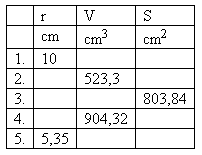
Solution:
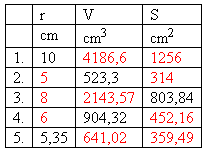
3. Three spheres with radii r1 = 3 cm, r2 = 4 cm, r3 = 5 cm are to be melted and cast into one sphere.
What will be the radius of this sphere?
Solution:
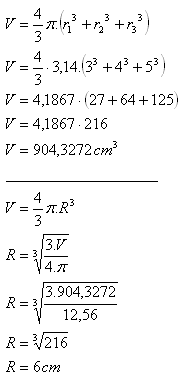
The radius of the new sphere will be R = 6 cm.
4. A cube is inscribed in a sphere with radius r = 6 cm.
What percent of the sphere’s volume does the cube’s volume constitute?
Solution:
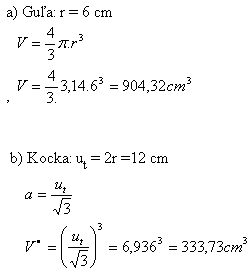
Percentage: 333.73 : 9.0432 = 36.9%
The cube’s volume is 36.9% of the sphere’s volume.
5. What is the mass of a hollow brass sphere (ρ = 8.5 g·cm-3) if the outer diameter is D = 12 cm and the wall thickness is h = 2 mm?
Solution:
D = 12 cm
R = 6 cm
h = 2 mm = 0.2 cm
r = R – h = 6 – 0.2 = 5.8 cm
ρ = 8.5 g·cm
-3
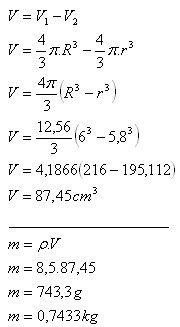
6. A sphere and a cone are inscribed in a right circular cylinder.
Determine the ratio Vk : Vg : Vv.
Solution:
Archimedes’ problem
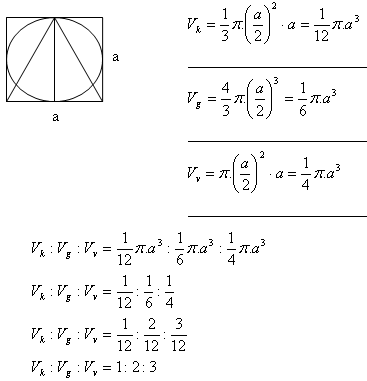
The ratio V
k : V
g : V
v = 1 : 2 : 3.
7. A planar cross-section of a sphere has length l = 125.6 cm. The distance of the section from the center of the sphere is v = 6 cm.
Determine the sphere’s radius and its volume.
Solution:
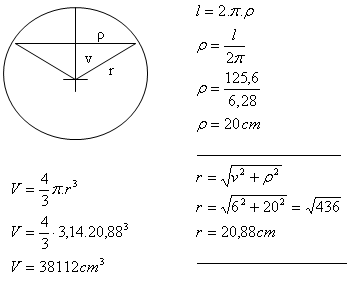
The radius of the sphere is r = 20.88 cm, its volume is V = 38112 cm
3.
8. A spherical segment with height v = 5 cm has volume V = 850 cm3.
Determine the radius r of the original sphere.
Solution:
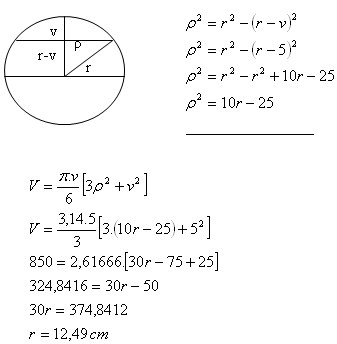
The radius of the original sphere is r = 12.49 cm.
9. The height of a spherical cap equals one third of the sphere’s radius.
In what ratio is the sphere’s surface area to the area of the cap?
Solution:
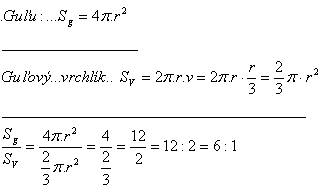
The ratio is S
g : S
v = 6 : 1.
10. Calculate the mass of a biconvex glass lens (ρ = 3.5 g·cm-3) with diameter 10 cm and thickness 1.2 cm.
Solution:
The lens consists of two identical spherical segments.
2p = 10 cm
2v = 1.2 cm
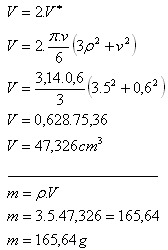
The mass of the lens is m = 165.64 g.